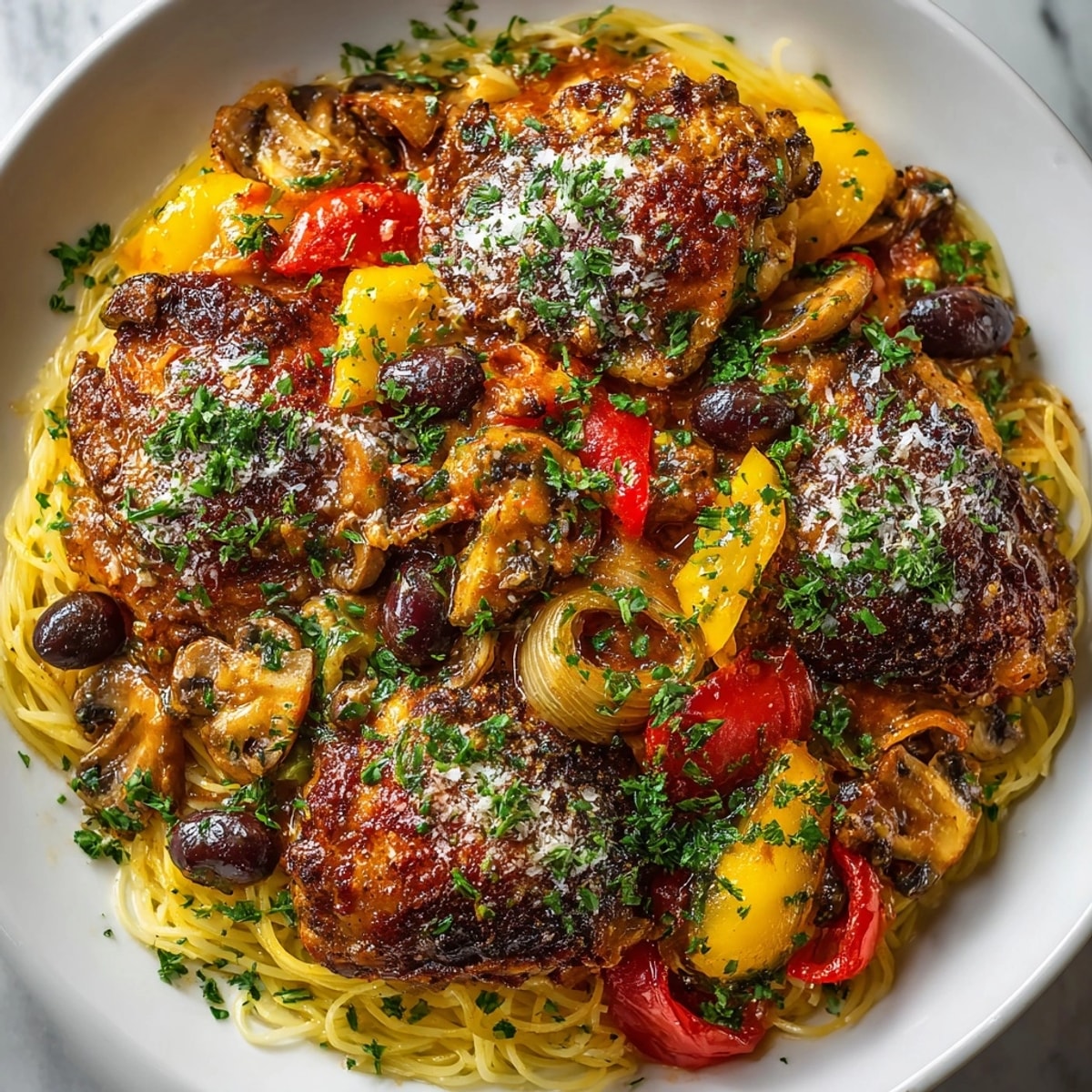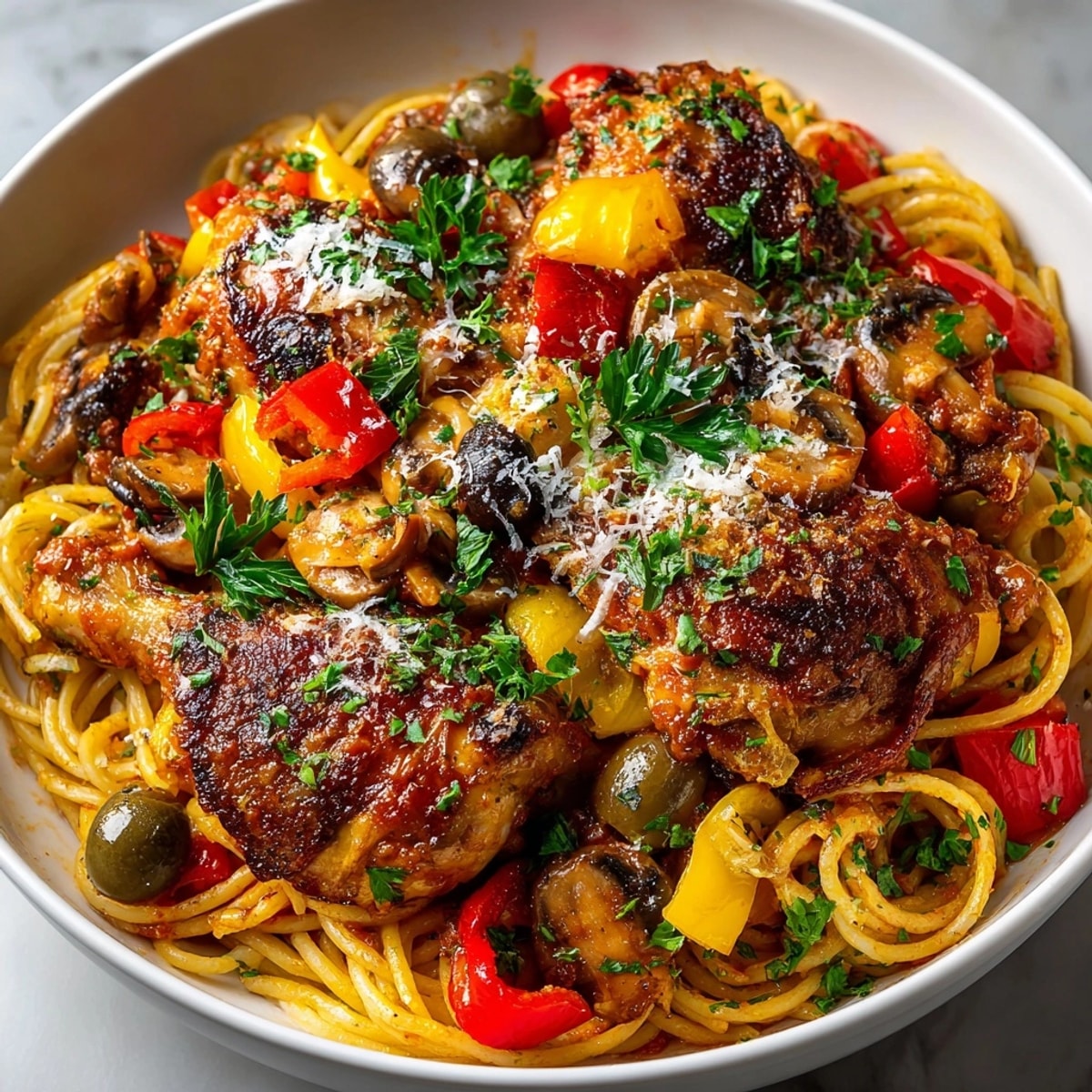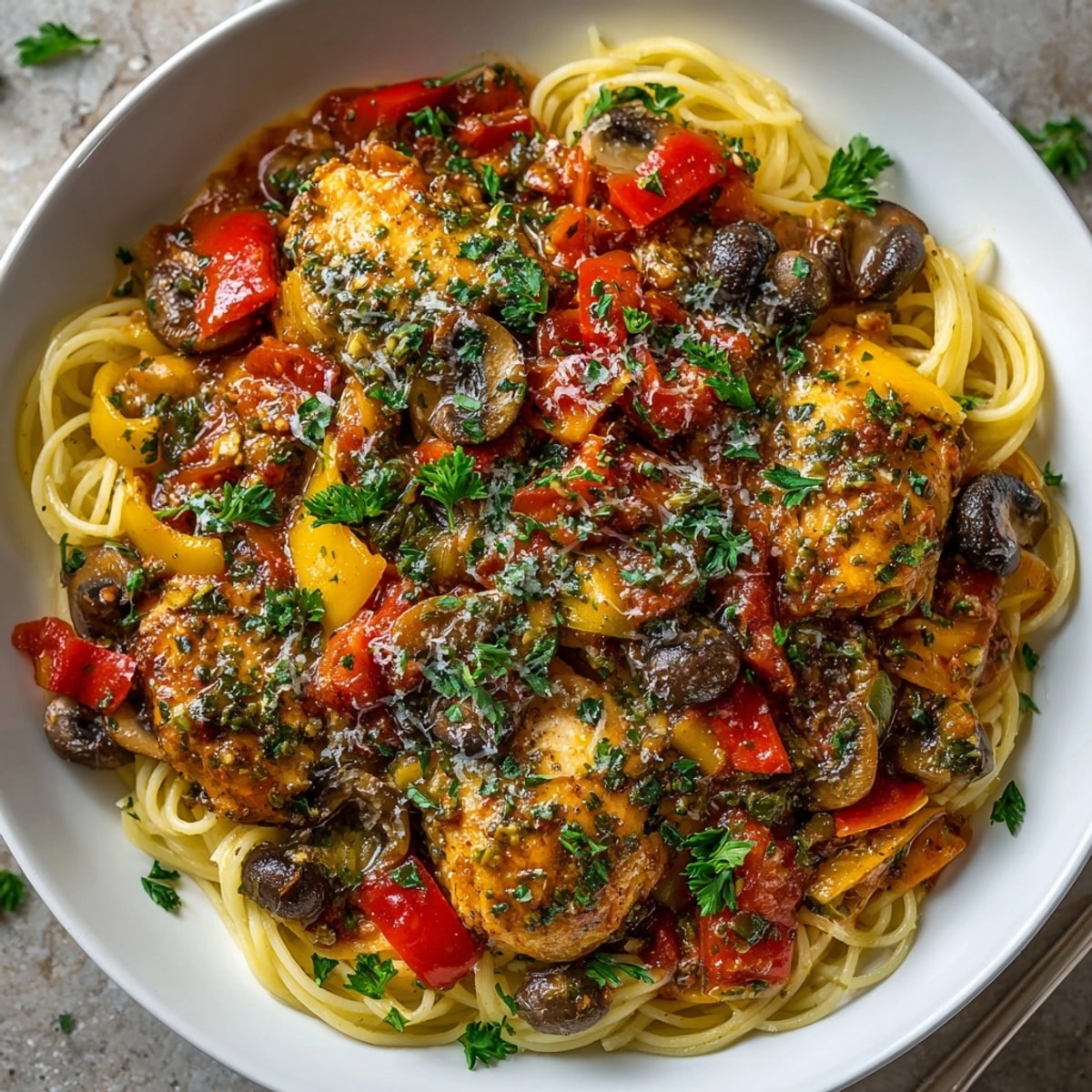 Save
Save This rustic Chicken Cacciatore has been my secret weapon for dinner parties and family gatherings for years. The rich tomato sauce infused with wine, herbs, and tender chicken creates an impressive yet approachable Italian classic that always leaves everyone asking for seconds.
I first made this recipe when trying to recreate my grandmother's version that I remembered from childhood. After several attempts and some advice from an Italian neighbor, this version emerged as the family favorite that my children now request for their birthday dinners.
Ingredients
- Bone in skin on chicken thighs and drumsticks: provide rich flavor and stay juicy throughout cooking. The skin adds golden color and depth to the sauce.
- Yellow onion and bell peppers: form the aromatic vegetable base. Look for firm peppers with glossy skin.
- Dry white wine: adds acidity and helps deglaze the pan. Choose something you would drink like Pinot Grigio or Sauvignon Blanc.
- Crushed tomatoes: create the backbone of the sauce. San Marzano tomatoes offer superior flavor if available.
- Dried herbs including oregano and basil: infuse the sauce with classic Italian flavors. Crush them between your fingers before adding to release more oils.
- Black olives and capers: introduce briny notes that balance the richness. Kalamata olives provide the best flavor profile.
- Pasta: serves as the perfect vehicle for the sauce. Choose a substantial shape like spaghetti or fettuccine that can stand up to the hearty sauce.
Instructions
- Prepare the Chicken:
- Season chicken pieces generously with salt and pepper on all sides. Take time to thoroughly pat the chicken dry with paper towels first this ensures proper browning and prevents steaming. The seasoning should be applied evenly, focusing on both the skin and meat sides.
- Create the Golden Sear:
- Heat olive oil in a large Dutch oven until shimmering but not smoking. Place chicken skin side down without overcrowding the pan. Allow each piece to develop a deep golden crust before turning, about 5 to 7 minutes per side. This step creates tremendous flavor that will infuse the entire dish. Transfer the seared chicken to a clean plate.
- Build the Vegetable Base:
- Add sliced onions and bell peppers to the same pan, using their moisture to help loosen the browned bits from the bottom. Cook for 4 to 5 minutes until they begin to soften but still retain some texture. The vegetables will absorb the chicken flavor left in the pan. Add garlic and mushrooms, cooking for another 3 minutes until fragrant.
- Deglaze and Create the Sauce:
- Pour in the white wine, using a wooden spoon to scrape up all the flavorful browned bits from the bottom of the pan. Allow the wine to simmer and reduce slightly for about 2 minutes, concentrating its flavor. Add crushed tomatoes, tomato paste, and dried herbs, stirring to combine thoroughly.
- Simmer to Perfection:
- Return the chicken to the pan, nestling each piece into the sauce so it's partially submerged. Cover and reduce heat to maintain a gentle simmer for 30 minutes, allowing the chicken to cook through and become tender. Remove the lid and continue cooking for 10 more minutes to thicken the sauce and intensify flavors.
- Finish the Dish:
- Add olives and capers during the final minutes of cooking, which preserves their distinct flavors and textures. Remove the bay leaves before serving. Taste the sauce and adjust seasoning with salt and pepper as needed. The sauce should be rich, slightly tangy, and deeply savory.
- Prepare the Pasta:
- Cook pasta in generously salted water until al dente according to package directions. Reserve a small cup of pasta water before draining in case you need to loosen the sauce later. Time this step so the pasta finishes cooking just as the chicken is ready.
- Serve with Style:
- Arrange a bed of pasta on each plate, then top with chicken pieces and generous spoonfuls of sauce. Sprinkle with fresh parsley and offer grated Parmesan at the table. The presentation should showcase both the pasta and the beautifully braised chicken.
 Save
Save My favorite part of this dish is how the chicken becomes incredibly tender as it simmers in the sauce. I remember making this for my husband on our first anniversary, and now it's become our tradition to prepare it together every year, adding a new ingredient or technique we've learned to make it even better.
The History Behind Chicken Cacciatore
Chicken Cacciatore originated in central Italy, where hunters would cook their catch with ingredients they carried with them, like wine, olive oil, and herbs. The dish traditionally used rabbit or game birds, but chicken became the popular choice as it became more widely available. Each Italian region has its own variation. Northern regions often use white wine while southern versions feature red wine and sometimes spicy peppers. This recipe uses white wine for a slightly lighter flavor that lets the vegetables shine through.
Make-Ahead and Storage Tips
This dish actually improves with time as the flavors meld together. You can prepare the entire recipe up to two days ahead, storing it in the refrigerator in an airtight container. Just reheat gently on the stovetop until the chicken reaches 165°F. For longer storage, portion the cooled cacciatore into freezer containers, leaving the pasta out. It will keep beautifully for up to three months. Thaw overnight in the refrigerator before reheating. Cook fresh pasta when ready to serve for the best texture.
Perfect Pairings
Chicken Cacciatore pairs wonderfully with a variety of sides beyond the traditional pasta. Try serving it with creamy polenta for a comforting alternative that soaks up the sauce beautifully. A simple arugula salad dressed with lemon and olive oil provides a peppery contrast to the rich sauce. For wine, choose medium-bodied Italian reds like Chianti Classico or Montepulciano d'Abruzzo that complement the tomato-based sauce without overwhelming the dish.
Ingredient Substitutions
No white wine? Apple cider vinegar diluted with chicken broth makes a good alcohol-free alternative
Boneless skinless chicken thighs can replace bone-in pieces, reducing cooking time to about 20 minutes
For a vegetarian version, use portobello mushrooms and eggplant in place of chicken, adding extra olive oil for richness
Seasonal Adaptations
Use fresh garden tomatoes instead of canned for brighter flavor
Add fresh basil at the end instead of dried herbs
Include summer squash or zucchini with the bell peppers
Winter Comfort
Add root vegetables like carrots and parsnips for heartiness
Increase red pepper flakes for warming heat
Serve over creamy polenta instead of pasta for extra comfort
 Save
Save The presentation should showcase both the pasta and the beautifully braised chicken.
Recipe FAQ
- → What type of chicken works best?
Bone-in, skin-on thighs and drumsticks create deeper flavor and tenderness, but chicken breast can be used with shorter simmering times.
- → Can I make this dish gluten-free?
Yes, substitute traditional pasta with your favorite gluten-free pasta variety for a wheat-free meal.
- → What's the purpose of using wine?
Dry white wine adds bright acidity and depth, enhancing the overall sauce richness. It cooks off, leaving only flavor behind.
- → Which vegetables are essential?
Onion, bell peppers, garlic, and mushrooms are key for building the sauce’s flavor and body.
- → How can I adjust the spice level?
Add or reduce crushed red pepper flakes to taste, or omit them for mild flavor.
- → What’s the best pasta shape to use?
Spaghetti or fettuccine are traditional, but any hearty pasta shape will hold the sauce well.